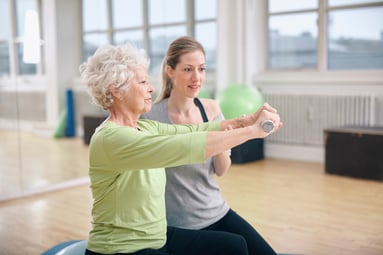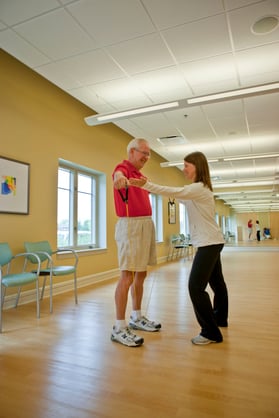Now it is time to apply what you learned in Part 1. Let’s look back on some key points:
- Only 12% of the U.S. population is health literate.
- Health and safety information should be delivered on a fifth-grade level.
- “Why” is a crucial question to ask and to answer in resident wellness.
Did you think about how you and your clients communicate and how instruction is delivered? Do you talk to your clients, or do your discuss with your clients? Let me ask you this: How often are you creative with your answers? How often do you use analogies that can be seen in the everyday world?
The Power of Analogies in Senior Fitness Education
I love using analogies. The body is an amazing machine, but also a mystery to many. I know we have all explained osteoarthritis many times over in our careers, but how well is the message getting through to the client? We can try to explain that the cartilage in the knee has slowly been worn down over time due to previous damages that may have occurred.
Now imagine that you have no idea what cartilage is, or can’t picture it. Would anything after that word mean anything to you? Probably not. So let’s put some visualization to this. Cartilage covers bones where they will meet with other bones and rub together. It is like a wet plastic sheet. Over time, damage happens because of impact from the many falls, running, and jumping that we have done. It also becomes more dry and brittle as we get older. Because of the damage and the dryness, the bones do not slide across each other smoothly anymore. The rough surfaces rubbing together will cause more damage, and the moist plastic lining is not there anymore to stop the bones from rubbing together. This explanation took a little longer, but I also know that the client now has a good picture in their mind of what is happening inside their knee.
Perspective and Visualization
One surprising statistic I learned while in my physics class in college is that if you hold a gallon of water straight out in front of you, your shoulder has about 100 pounds of pressure on it, even though a gallon of water is approximately 8 pounds. This is a statistic I am always passing on to my senior wellness clients. It can be very hard to understand why such a small weight is so difficult to lift, and maybe even painful. Some even feel embarrassed that they can’t lift a larger amount of weight. As soon as I tell them this, there is always a light bulb that goes off, along with surprise, of course. Again, the body is a machine. Machines follow the laws of physics, but how many of us can explain physics well enough for a fifth-grader to understand? Visualization is key.
Working with Plain Language: A Training Manual, written by William H. DuBay, has a great deal of information on the background of plain language, why it is necessary, and how to apply it in all manners.
One of our greatest joys as health, wellness, and fitness specialists is seeing the people we work with succeed. So let’s find that common ground where we are not just talking to our clients, but discussing with our clients about their health, wellness, and happiness.
Interested in how you can do wellness better for your residents? Grab our quick read below to see how you can better evaluate your wellness offerings in your senior living community.



 In the fitness and health field, we are asked for advice continually. It is our job to build fitness routines that are safe, comfortable, and something our clients will actually build into an overall resident wellness lifestyle. The difficult part always seems to be creating a program that they like that also fits around all contraindications of diseases and ailments, and having them not give up after a week.
In the fitness and health field, we are asked for advice continually. It is our job to build fitness routines that are safe, comfortable, and something our clients will actually build into an overall resident wellness lifestyle. The difficult part always seems to be creating a program that they like that also fits around all contraindications of diseases and ailments, and having them not give up after a week.